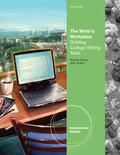
For more than 20 years, THE WRITER'S WORKPLACE has served the needs of more than half a million two- and four-year students as they have worked their way toward rewarding careers in a variety of fields. Sandra Scarry and John Scarry present writing instruction in a clear and inviting form, with step-by-step explanations to help build and maintain students' confidence in their writing. The result of many years of classroom teaching and research, this comprehensiveand time-tested resource reflects the authors' understanding that students are unique individuals, with diverse backgrounds and interests that must be accounted for as they engage in the writing process. INDICE: PART I: AN INVITATION TO WRITING. 1. Gathering Ideas for Writing. 2. Recognizing the Elements of Good Writing. PART II: CREATING EFFECTIVE SENTENCES . 3. Finding Subjects and Verbs in Simple Sentences. 4. Making Subjects and Verbs Agree. 5. Understanding Fragments and Phrases. 6. Combining SentencesUsing Three Options for Coordination. 7. Combining Sentences Using Subordination. 8. Correcting Fragments and Run-Ons. 9. Choosing Correct Pronouns. 10. Working with Adjectives, Adverbs, and Parallel Structure. 11. Practicing Irregular Verbs. 12. Mastering Verb Tenses. 13. Using Correct Capitalization and Punctuation. PART III: UNDERSTANDING THE POWER OF WORDS 14. Choosing Words That Work. 15. Paying Attention to Look-Alikes and Sound-Alikes. PART IV: CREATING EFFECTIVE PARAGRAPHS. 16. Working with Paragraphs: Topic Sentences and Controlling Ideas. 17. Working with Paragraphs: Supporting Details. 18. Developing Paragraphs: Illustration. 19. Developing Paragraphs: Narration. 20. Developing Paragraphs: Description. 21. Developing Paragraphs: Process Analysis. 22. Developing Paragraphs: Comparison/Contrast. 23. Developing Paragraphs: Cause and Effect. 24. Developing Paragraphs: De?nition and Analysis. 25. Developing Paragraphs: Classification. PART V: STRUCTURING THE COLLEGE ESSAY. 26. Moving from theParagraph to the Essay. 27. Following the Progress of a Student Essay. 28. Writing an Essay Using Examples, Illustrations, or Anecdotes. 29. Writing an Essay Using Narration. 30. Writing an Essay Using Process Analysis. 31. Writing an Essay Using Comparison/Contrast. 32.Writing an Essay Using Persuasion. 33. Other College Writing: The Research Paper and the Essay Exam.
- ISBN: 978-0-495-90976-7
- Editorial: Heinle & Heinle
- Encuadernacion: Rústica
- Páginas: 704
- Fecha Publicación: 31/01/2010
- Nº Volúmenes: 1
- Idioma: Inglés
